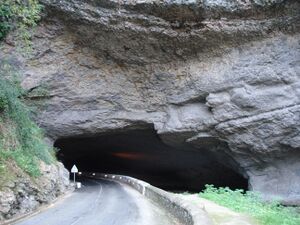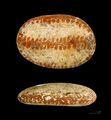أزيلية
 | |
| النطاق الجغرافي | Western Europe |
|---|---|
| الفترة | Epipaleolithic or Mesolithic |
| التواريخ | 12,500–10,000 BP[1] |
| الموقع النمطي | Le Mas-d'Azil |
| سبقها | Magdalenian |
| تلاها | Maglemosian culture, Sauveterrian |
| العصر الحجري الوسيط Epipaleolithic |
|---|
| ↑ العصر الحجري القديم |
| ↓ العصر الحجري الحديث ↓ العصر الحجري |
الأزيلية (Azilian) هي حضارة كهفية ظهرت في العصر الحجري الوسيط منذ 8000سنة ق.م. . والأزيليون شعب له حضارته التي ترجع سماتها لقرية مادازيل قرب تولوز بشمال أسبانيا وجنوبي غرب فرنسا . وكانوا جامعي طعام . واستخدموا المكاشط الصغيرة لسلخ الحيوانات وكان لديهم آلات من العظام وقرون الوعول ومن بينها حراب الصيد وكانت تصنع من العظام وأشكالها تميز الحضارة الأزيلية .وعثر علي جماجم وضعت بإتجاه الغرب وكانوا يذبحون الحيوانات من رقبتها . وكانوا يدهنون الجماجم بالغراء الأحمر . وهذه الحضارة الكهفية تضم كهوفا في فرنسا ووسط أوروبا وبلجيكا وبريطانيا .
Harpoon – Mas d'Azil – Museum de Toulouse
Painted pebble – Mas d'Azil – Museum de Toulouse
Azilian point - Tourasse Cave – Museum de Toulouse
In Southern Iberia
A culture very similar to the Azilian spread as well into Mediterranean Spain and southern Portugal. Because it lacked bone industry it is named distinctively as Iberian microlaminar microlithism. It was replaced by the so-called geometrical microlithism related to Sauveterrian culture.
Genetics
In a genetic study published in 2014, the remains of an Azilian male from the Grotte du Bichon were examined. He was found to be carrying the paternal haplogroup I2 and the maternal haplogroup U5b1h.[2]
Villalba-Mouco et al. 2019 examined the remains of two males of the Azilian culture buried at the Late Upper Paleolithic site of Balma de Guilanyà, Catatonia, Spain c. 11,380-9,990 BC. They were found to be carrying the paternal haplogroups I and C1a1a, and the maternal haplogroups U5b2a and U2'3'4'7'8'9. They had a significant genetic affinity to earlier individuals of the Magdalenian culture.[3]
انظر أيضاً
Notes
- ^ Barbaza, Michel (2011). "Environmental changes and cultural dynamics along the northern slope of the Pyrenees during the Younger Dryas" (PDF). Quaternary International. 242 (2): 313–327. Bibcode:2011QuInt.242..313B. doi:10.1016/j.quaint.2011.03.012.
- ^ Fu 2016.
- ^ Villalba-Mouco et al. 2019.
References
- Bailey, Geoff and Spikins, Penny, Mesolithic Europe, 2008, Cambridge University Press, ISBN 0521855039, 9780521855037
- Henry Fairfield Osborn, Men of the Old Stone Age, from www.gutenberg.org, 1916 (greatly outdated in many respects)
- Ian Shaw, Robert Jameson, eds., "Azilian" and "Azilian pebbles" in A Dictionary of Archaeology, 2002, Oxford: Blackwell Publishers ISBN 0-631-17423-0, google books
Sources
- Fu, Qiaomei (May 2, 2016). "The genetic history of Ice Age Europe". Nature. Nature Research. 534 (7606): 200–205. doi:10.1038/nature17993. hdl:10211.3/198594. PMC 4943878. PMID 27135931.
- Villalba-Mouco, Vanessa; et al. (April 1, 2019). "Survival of Late Pleistocene Hunter-Gatherer Ancestry in the Iberian Peninsula". Current Biology. Cell Press. 29 (2): 1169–117. doi:10.1016/j.cub.2019.02.006. PMID 30880015. Retrieved November 12, 2020.


